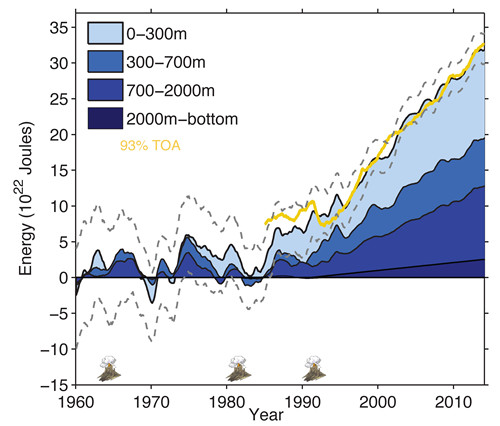
Global warming is driven by the Earth’s energy imbalance (EEI): our planet traps more and more heat due to continuous increasing greenhouse gases. From the energy perspective, the global warming is actually ocean warming, since ocean stores more than 90% of the trapped heat. Therefore, ocean heat content (OHC) change is a fundamental indicator of global warming, thus direct measurement of OHC will provide a direct evidence for climate change.
Reliable assessment of historical OHC change is a key task in climate studies. OHC time series provided by independent international groups show large discrepancies for long-term trend, intra-seasonal, inter-annual and decadal variability, because there are many challenges in estimating historical OHC change.
“One of the major ocean subsurface observations (i.e. XBT) contains systematic bias,” said Dr. CHENG Lijing from the Institute of Atmospheric Physics (IAP) of the Chinese Academy of Science, also a lead author of a study (Cheng et al. 2017) recently published in Science Advances, “Besides, temperature observations at ocean subsurface are extremely sparse, especially before 2005, since they were mainly distributed along the major shipping routes in the Northern Hemisphere.”
During the recent decade, a new type of sensing device has been deployed (the Argo float system), which significantly increases the coverage of ocean data. However, there are still more than 60% of the ocean grids without any observations (if the global ocean is divided into 1 degree and 1 month grids). So a gap-filling method is required to make a “guess” for the temperature change in the ocean grids without observations. This “guess” is based on the spatial and temporal covariance of ocean temperature changes. In another word, the ocean changes at two locations are not completely independent; instead, they are correlated under physical rules. The gap-filling method works to utilize the correlation to reconstruction the missed information. The choice of different gap-filling methods is the major error source in global OHC calculation.
This study led by IAP, collaborated with NCAR, NOAA, and University of St. Thomas, made a major step to estimate historical OHC change. The new study applied an advanced XBT bias correction method, which is recommended according to an XBT community paper published in 2016 in Bulletin of the American Meteorological Society. This ensures that the observation bias is minimized. The key step made by the new study is the application of an advanced gap-filling method and a careful evaluation on the results. It is highlighted that this study uses the knowledge of recent well-observed ocean states, but subsample it using the sparse distribution of observations in the more distant past to show that the method produces startling good results since late 1950s.
This new work allows a more accurate assessment of how much heat has accumulated in the ocean (and Earth) system. The inferred ocean energy accumulation (Fig.1) is larger than previous estimates, such as from the last Intergovernmental Panel on Climate Change Fifth Report (IPCC-AR5) in 2013. But it is consistent with the direct observations of Earth’s energy imbalance at top of atmosphere (yellow in Fig.1) since late 1980s. This new look at OHC and EEI changes over time provides greater confidence than previously possible, and the data sets produced are a valuable resource for further climate change study.

Figure 1.Ocean energy budget estimated by Cheng et al. 2017. The 93% of the energy imbalance observed from the top of atmosphere is shown in yellow (Cheng et al., 2017)
“This study provided a new reconstruction on ocean subsurface temperature change since 1960 for 0-2000m depths, and assessed historical ocean energy budget more accurately. So it will be a valuable resource for future studies of oceanic variability and its climatic impacts on both regional and global scales,” commented Prof. WANG Fan, deputy director of Institute of Oceanography, Chinese Academy of Science.

86-10-68597521 (day)
86-10-68597289 (night)

86-10-68511095 (day)
86-10-68512458 (night)

cas_en@cas.cn

52 Sanlihe Rd., Xicheng District,
Beijing, China (100864)

